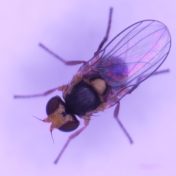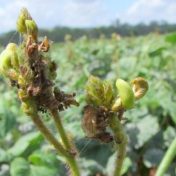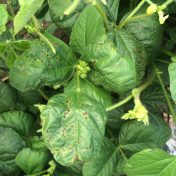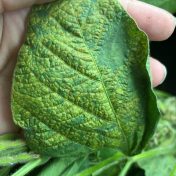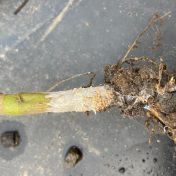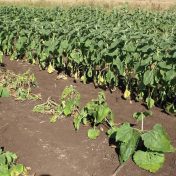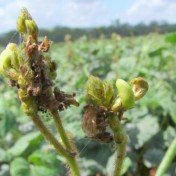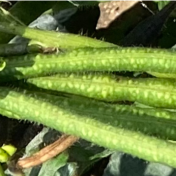As we approach the end of the mungbean season in southern Queensland, there have been several reports of pest fly infestations in mungbean crops, including bean fly (Ophiomyia phaseoli) attacking later stage crops, along with infestations of the relatively recent invader the American serpentine leaf miner (Liriomyza trifolii). Late bean fly infestations Late bean fly damage was recently observed in… Read more »
QDPI entomologists have received several recent reports of poor control after spraying bean podborer (Maruca vitrata) in Central Queensland mungbean crops. A major pest of mungbeans in tropical and subtropical production areas, bean podborer is typically more problematic in coastal cropping regions and can be more difficult to manage than co-occurring Helicoverpa sp. populations. Infestation pattern and nature of damage… Read more »
Powdery mildew is a fungal disease that is commonly seen each cropping season in most mungbean paddocks in Australia. In Queensland and northern New South Wales, disease outbreaks usually occur from early autumn in the summer planted crops, with epidemics typically developing as soon as temperatures drop. Initial symptoms are easy to recognise: small whitish, powdery spots on the upper… Read more »
A wet spring has led to outbreaks of halo blight in several spring-planted mungbean crops throughout southern Queensland. Tan spot has also been detected in some crops. Avoid replanting seed from crops affected with halo blight and tan spot and minimise the spread of these diseases by restricting access and ensuring good farm hygiene. Avoid movement through infected paddocks and… Read more »
Earlier this year, the Queensland Department of Primary industry (DPI) pathology team received samples of soybean with virus-like symptoms. Diseased plants displaying strong chlorotic mottle on leaves and leaf crinkling (see images below) were scattered through the crop. While the samples tested positive in a polymerase chain reaction (PCR) test for potyvirus, the actual species remained a mystery. Subsequent sequencing… Read more »
Warm, wet conditions have led to isolated outbreaks of the fungal pathogen, Sclerotium rolfsii, in sorghum and grain legume crops across southern Queensland (although other regions are also at risk) and several disease outbreaks in mungbean crops growing throughout Queensland and northern New South Wales. Sclerotium rolfsii Sclerotium is a soilborne pathogen that can infect a wide range of plant… Read more »
The recent declaration of El Niño conditions for eastern Australia means an increased chance of below average rainfall. Historically, these conditions can lead to more severe outbreaks of tobacco streak virus. However, with forward planning and selection of suitable sunflower hybrids, the risk of economic impacts from TSV can be avoided. If sunflowers crops are planned for early 2024 in… Read more »
A new APVMA permit (PER 93132) allows the use of a spray drift management tool (SDMT) to re-calculate buffer zones to suit your particular situation when applying some pesticides. The SDMT (available as a spreadsheet file) and other relevant documentation (including a video on how to use the calculator) and a copy of PER93132 can be found on the APVMA… Read more »
There have been several reports of Fusarium wilt affecting mungbean paddocks throughout southern Queensland within the last couple of weeks. Monitor crops closely for disease symptoms, and contact our plant pathologist, Lisa Kelly at [email protected] or 0477 747 040 for further information on disease diagnosis. Minimise the spread of the disease by avoiding movement through infected paddocks and thoroughly removing… Read more »
A severe outbreak of phytoplasma disease has been reported in mungbeans from the Burdekin region. Symptoms of little leaf, phyllody (greening of flower structures) and puffy pod became obvious in mid-late October and have now affected a high incidence of plants in a 25 ha planting. Puffy pod affected plants typically remain green for longer than healthy mature plants. This… Read more »
